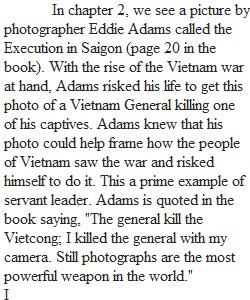


Q After reading Session 15, read the information below and think about your answers. Remember to post your answers and also respond to three other classmates' posts. This is due within this session fifteen. You have been participating with many types and forms of fine arts. This course is an overview of many arts forms and their influences. We have gone back in time, as well as experienced, on all levels and through many themes, some of the contemporary arts of today. Words only serve as a convenience for us as we try in some way to cope with what we see and what we hear, how and why we try to share them with others. Number 1, 2 and 3 and answer the discussion topics and questions below: 1) Using the text, find a favorite work of visual or performing art that you consider to be a product of or example of "servant leadership." Seek a work created by a visual artist, musician, film maker, or playwright who was in their day and time or is currently a servant leader. They are not just "a leader," but you find some indication that he or she is also a servant leader. Indicate the title, artist, and page number. Discuss why were you drawn to this particular piece as an example of servant leadership. 2) Find one work of art in the text that reminds you of you ... or of something important or a special memory in your life. Indicate the title, artist, and page number. Why did you select the work? How does it take you back in time? How do you personally relate to this work? Discuss your thoughts and how the work makes you feel as you first analyze and then discuss this work. 3) The real life, the enthusiasm, the enjoyment, and the meaning of the arts from our class ... lead us to what happens next. How do you think this course in the arts will impact your life? What, in the arts, do you hope will be in the future for YOU? (Remember to also thoughtfully respond to the posts of three of your classmates.)
View Related Questions